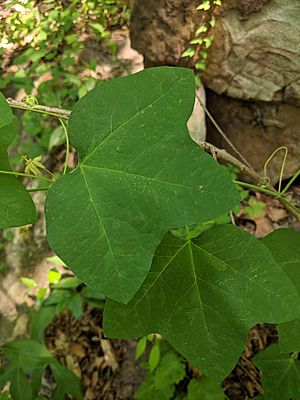Yellow passionflower facts for kids
Quick facts for kids Yellow passionflower |
|
|---|---|
 |
|
| Flower | |
| Scientific classification | |
| Genus: |
Passiflora
|
| Species: |
lutea
|
The yellow passionflower (Passiflora lutea) is a cool flowering plant. It belongs to the Passifloraceae family. You can find it growing in eastern and south-central North America. It stretches from Pennsylvania west to Kansas, and south to Florida and Texas. This plant is special because it's the northernmost type of passionflower. It can handle cold winters, even freezing temperatures down to -15 °C. It can even survive -30 °C for short times!
Contents
About the Yellow Passionflower
The yellow passionflower is a perennial plant. This means it lives for many years. It is a vine that can climb or spread along the ground. It can grow to be 3 to 5 meters (about 10 to 16 feet) long.
What It Looks Like
Its leaves have three parts, like a clover. They are 3 to 7 centimeters (about 1 to 3 inches) long. They can be 3 to 15 centimeters (about 1 to 6 inches) wide. In colder areas, the leaves fall off in winter.
The plant gets its name from its small, yellow-green flowers. They are about 1 to 1.5 centimeters (less than an inch) wide. These flowers bloom in the summer. After the flowers, small black berries grow. These berries hold the plant's bumpy brown seeds.
Where It Grows
Yellow passionflower likes places with some shade but also some sun. It grows best in soil that is moist and rich. It is very similar to another plant called Passiflora suberosa.
Friends in Nature
The yellow passionflower is great for butterfly gardens. It is a special plant for certain butterflies. These include the Gulf fritillary, julia butterflies, and zebra longwings. These butterflies lay their eggs on the plant. Their caterpillars then eat the leaves.
There is also a very rare bee called Anthemurgus passiflorae. This bee only collects pollen from the yellow passionflower. It is the only bee of its kind! Even though it loves this plant, it does not often pollinate it.
Conservation
In the state of Pennsylvania, Passiflora lutea is considered an endangered species. This means there are not many of these plants left there. People are working to protect them.
See also
 In Spanish: Passiflora lutea para niños
In Spanish: Passiflora lutea para niños


